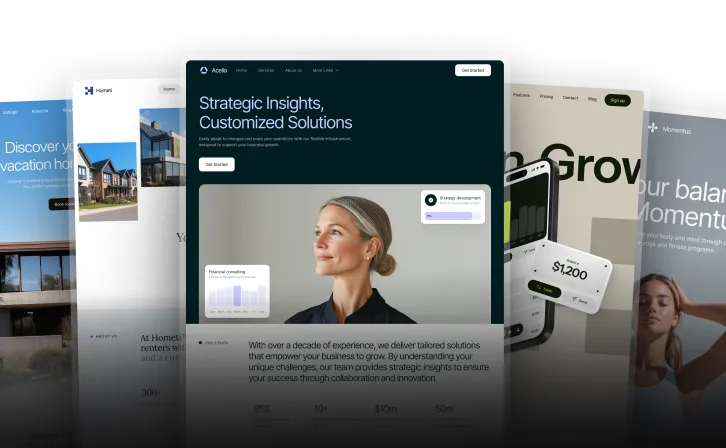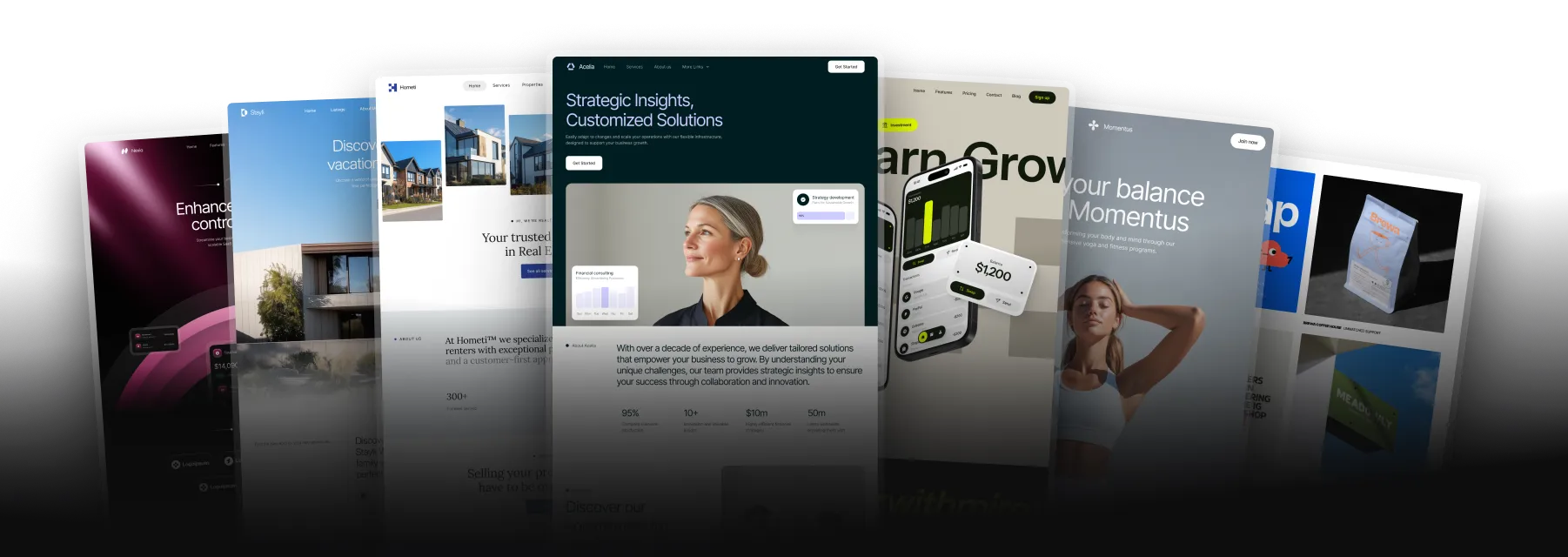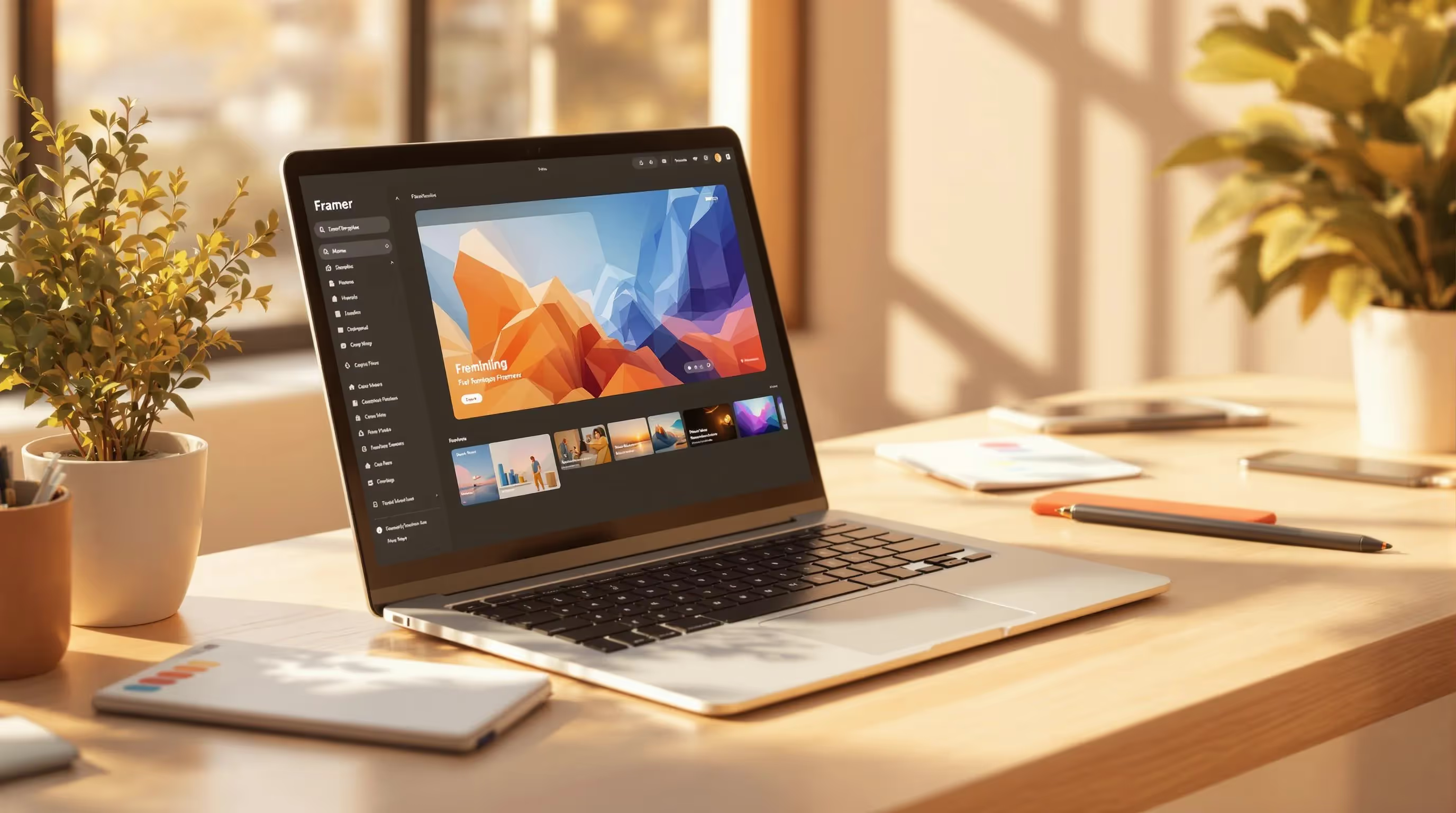The Complete Guide to Framer Templates
Unlock all templates




Framer templates make building websites fast and easy, even without coding. Here's what you need to know:
- What Are Framer Templates? Pre-designed website layouts with responsive designs, CMS integration, and customizable components.
- Why Use Them? They save time and improve workflow. Businesses like Dribbble and Acapela have reported faster deployment and better efficiency using Framer.
- Types of Templates: Categories include Agency & Portfolio, Business & SaaS, E-commerce, Blogs, and Landing Pages. Each is tailored for specific industries.
- How to Choose: Look for templates that match your industry, offer customization, and fit your budget (free to $129).
- Customization: Easily adjust colors, fonts, layouts, and add interactive elements without coding.
- Performance Tips: Optimize images, fonts, and animations to ensure fast load times and mobile-friendly designs.
Framer templates are ideal for creating professional websites quickly while maintaining flexibility and performance.
How to use a Framer Template

Selecting a Template
Framer templates can save time and improve workflow efficiency. But how do you pick the right one? The key is to choose a template that aligns with your design goals and technical requirements.
Key Selection Criteria
When evaluating templates, consider the following factors:
| Criteria | What to Look For |
|---|---|
| Industry Alignment | Templates designed with your sector in mind |
| Customization Options | The ability to tailor the design to fit your brand |
| Core Features | Built-in tools and elements you need |
| Performance | Fast-loading pages and responsive layouts |
| Budget | Prices range from free to $129 |
Make sure the template structure complements your content strategy. For example, a SaaS website might need features like product displays, pricing tables, or integration options. Let’s take a closer look at templates tailored for different industries.
Templates by Industry
Framer offers templates suited for a variety of sectors, helping businesses create polished websites without starting from scratch.
- Technology and SaaS: Miros ($129) offers a flexible layout perfect for software and financial services. Darken and Clikup (both $79) are great for showcasing tech services.
- Financial Services: Moneta ($79) and Advisora ($129) include layouts designed for financial presentations, complete with analytics integration.
- Creative Portfolios: Imagen Lite (Free) caters to UI/UX designers and photographers. Rosalia ($129) provides a sleek, contemporary look, while AnderDark ($79) adds CMS and e-commerce functionality.
- Professional Services: Legally ($79) features layouts tailored for case studies, client testimonials, and service overviews.
These templates help businesses launch visually appealing websites quickly while staying true to their brand identity.
Template Customization Steps
Once you've picked your template, the next step is making it fit your brand perfectly. Here's how to adjust your Framer template with both basic design tweaks and more advanced features.
Standard Design Changes
Start with simple updates to align the template with your brand's identity.
| Design Element | How to Customize | Tips for Consistency |
|---|---|---|
| Color Palette | Update theme colors in the design panel | Use color variables to keep things consistent |
| Typography | Change font styles and sizes | Stick to 2–3 font families for a clean look |
| Layout Structure | Adjust spacing and alignment | Use Stacks for layouts that adapt to different screens |
| Content Blocks | Replace placeholder text and images | Compress images with tools like TinyPNG for faster loading |
"With Framer's drag-and-drop interface, you can personalize colors, fonts, layouts, images, and interactions, all without needing technical expertise." - Harish Malhi, Founder of Goodspeed
Before making any big changes, create a backup copy of your project. Also, test updates in a staging environment to avoid surprises.
Complex Modifications
After nailing the basics, you can take your site to the next level with advanced features. These upgrades can add functionality and refine the user experience.
- Interactive Elements Add smooth animations using Framer Motion to improve how users interact with your site.
- Component Architecture Build reusable components with variants. For example, the Miros template ($129) uses this approach for pricing tables and feature displays.
-
Integration Setup
- Keep custom code to a minimum.
- Document all integrations clearly.
- Test for performance issues.
- Include error handling measures.
Set breakpoints for different devices: Desktop (1200px+), Tablet (768–1199px), and Mobile (below 768px). Organize your assets into well-named folders to keep things scalable and easy to manage.
sbb-itb-fdf3c56
Speed and Performance Tips
Fast site speed is critical. Make sure your Framer template is optimized for top-notch performance.
Performance Guidelines
A mobile delay of just one second can decrease conversions by 20%. Here's how to keep your site running efficiently:
| Element | Optimization Technique | Impact |
|---|---|---|
| Images | Use WebP/AVIF formats, enable auto resolution | Cuts file size by 25–34% |
| Videos | Embed via YouTube/Vimeo, avoid autoplay | Lowers server load |
| Fonts | Use Google Fonts or WOFF2 format | Speeds up page rendering |
| Animations | Limit blur values to under 10, use subtle effects | Boosts frame rates |
Breaking up large pages into smaller sections can also reduce DOM size and improve performance.
"Fast sites meet user expectations and earn search engine favor." - Harish Malhi, Founder of Goodspeed
Regularly check these optimizations with performance tests to maintain speed.
Speed Testing Methods
To keep your template running smoothly, focus on these essential metrics:
-
Core Web Vitals
- Largest Contentful Paint (LCP)
- First Input Delay (FID)
- Cumulative Layout Shift (CLS)
-
Load Time Targets
- Desktop: Under 2.5 seconds
- Mobile: Under 3 seconds
Here are some tools to measure and improve performance:
| Tool | Primary Use | Key Feature |
|---|---|---|
| Google Lighthouse | Comprehensive performance analysis | Detailed scoring system |
| GTmetrix | Load time insights | Tracks historical data |
| PageSpeed Insights | Mobile-specific performance | Real-world performance data |
| Debugbear | INP debugging | Interactive testing capabilities |
Since over 61.85% of global website traffic comes from mobile devices, prioritize mobile performance. Test your site on various devices and under different network conditions to ensure it performs consistently.
Quick Prototyping with Templates
Framer templates make it easier to go from idea to a live site quickly. By using these templates, designers can focus on creativity without getting stuck in the technical details of development.
How to Use Templates Effectively
Here’s a simple workflow to take your design from concept to a live site:
-
Pick the Right Template
Choose a template that aligns with your project’s goals and requirements. -
Customize It
Start by adding your brand's colors, fonts, and logo. Then, update CMS elements and replace placeholder content with your own. -
Add Interactive Features
Include interactive elements like smooth scrolling or pagination to enhance the user experience. -
Test and Refine
Use Framer's preview mode to check how your design looks on different devices. Share prototypes using QR codes for mobile testing, and gather team feedback to make improvements.
This process works hand-in-hand with earlier strategies for customization and performance, making development faster and more efficient.
Real-World Examples of Template Success
Acapela, a company that switched from Webflow to Framer in 2022, saw a huge reduction in the time it took to deploy pages. For larger teams, Framer templates improve collaboration, ensure consistent branding, and offer designs that can scale as projects grow. Some teams even reported up to a 25% improvement in page load speeds.
Smaller businesses and startups also benefit. For example, one tech startup saw a 20% boost in sign-up rates after adding an interactive demo to their landing page.
Conclusion
This guide has highlighted how Framer templates can streamline web design by offering both ease of use and customization options. They help you save time while maintaining high standards for your projects.
Key Takeaways
Here’s a quick recap of the main points:
- Template Selection: Explore categories like Real Estate, Business, Startup & SaaS, Technology, Portfolio, Wellness, E-commerce, Fitness, and Medical to find options tailored to your industry.
- Customization Options: Use templates as a starting point and modify them to reflect your brand and specific goals.
- Budget-Friendly Choices: Templates are available at a range of price points, making them accessible for various budgets.
These insights can help you jumpstart your next project with confidence.
How to Get Started
Follow these steps to begin your journey:
-
Pick Your Platform
Check out template marketplaces like Temlis, which offers options for both Webflow and Framer. Choose a design that suits your industry and project needs. -
Define Your Requirements
Identify your site’s purpose, must-have features, budget, and timeline before diving into customization. -
Make It Your Own
Personalize the template by incorporating your brand elements, updating the content, and ensuring it looks great on all devices.
Take the first step today and bring your vision to life!
Related Blog Posts
Recommended posts
Unlock all templates







